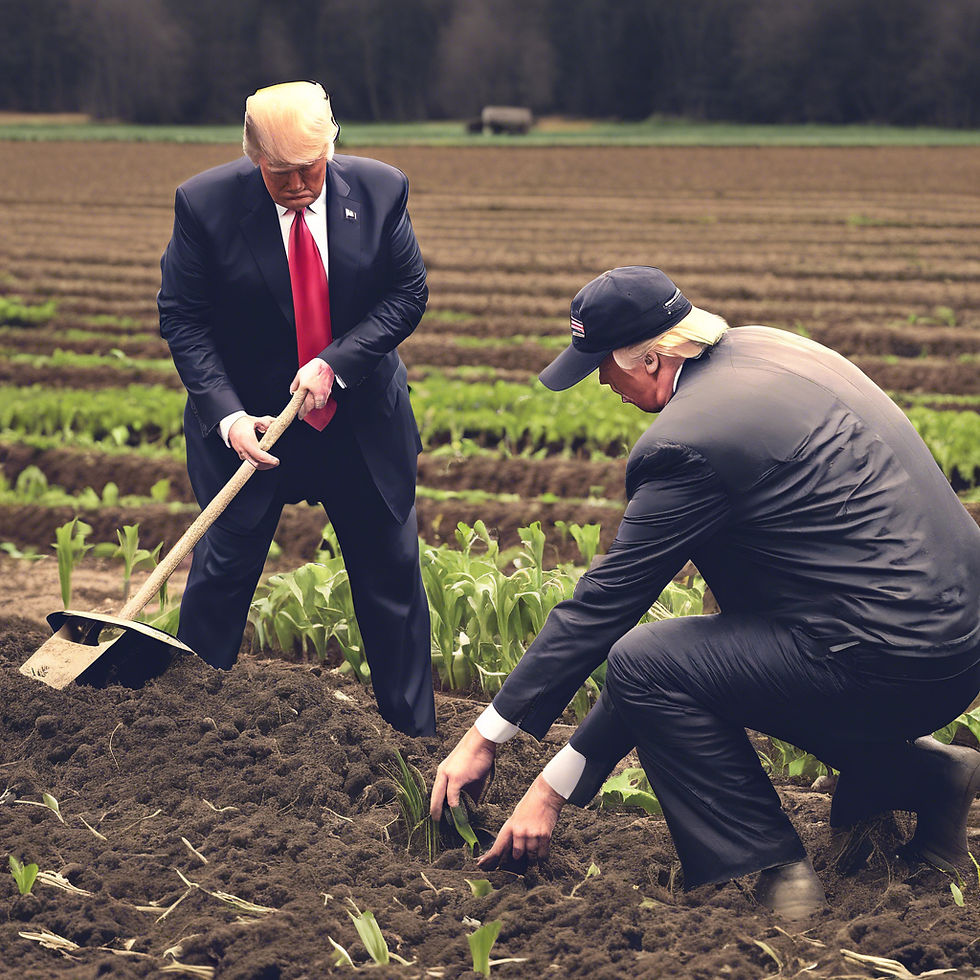The Impact of President Trump’s Executive Orders on Agriculture: A Perfect Storm?
- Malik Miller
- Jan 24
- 4 min read
Recent executive orders by President Donald Trump—one targeting Diversity, Equity, and Inclusion (DEI) programs and another imposing stricter immigration policies—are poised to reshape the U.S. agricultural sector. These policies, while rooted in broader political goals, are likely to have profound implications for the labor force, operations, and long-term sustainability of agriculture. In this blog, we’ll explore how these measures could affect one of the nation’s most critical industries.

Understanding the Policies
1. Termination of DEI Programs
President Trump’s executive order eliminates federal DEI initiatives, disbanding programs designed to promote inclusivity, equity, and diversity within workplaces and communities. In agriculture, these programs often provide minority and socially disadvantaged farmers with grants, technical assistance, and training opportunities. They also encourage diversity in the agricultural workforce.
2. Stricter Immigration Policies
The second executive order significantly tightens immigration controls, focusing on deportations, enhanced border security, and restrictions on legal immigration pathways. These policies directly impact the immigrant labor force—a cornerstone of the agricultural industry, where over 70% of hired farmworkers are immigrants, according to the U.S. Department of Agriculture (USDA).
The Ripple Effects on Agriculture
1. Labor Shortages
The agricultural sector is heavily reliant on immigrant workers for planting, harvesting, and processing crops. Stricter immigration enforcement and mass deportations threaten to reduce the labor pool significantly.
Harvest Delays and Reduced Yields: Crops that require intensive manual labor, such as berries, lettuce, and tomatoes, are at particular risk of delayed harvesting or rotting in fields due to insufficient workers.
Higher Labor Costs: With fewer workers available, wages are likely to rise as farms compete for labor, increasing operational costs and squeezing already tight profit margins.
Smaller farms, often less able to absorb these costs, could face financial crises, while larger agribusinesses may turn to automation—an option unavailable to many smaller operations.
2. Financial Strains for Minority Farmers
The termination of DEI programs may have a disproportionate effect on minority farmers, who often rely on federal assistance for:
Accessing capital.
Modernizing equipment.
Participating in educational programs that enhance business skills and sustainability practices.
Without these supports, socially disadvantaged farmers could struggle to remain competitive, widening existing inequities in the industry.
3. Food Supply Chain Disruptions
The labor shortages caused by stricter immigration policies could have cascading effects throughout the food supply chain:
Reduced Production: With fewer workers to plant, tend, and harvest crops, overall agricultural output may decline.
Higher Consumer Prices: Reduced supply often leads to increased food prices, making fresh produce less accessible to consumers.
Economic Impacts on Rural Areas: Agriculture is a cornerstone of rural economies, and disruptions in farming operations could have far-reaching economic consequences for these communities.
4. Stalling Innovation and Sustainability
DEI programs often foster innovation by bringing diverse perspectives to problem-solving in areas like sustainability and agri-tech. Their termination could stifle this creativity and limit opportunities to address pressing challenges such as climate change and resource scarcity.
Furthermore, international collaboration—a vital aspect of agricultural innovation—may suffer under stricter immigration policies, restricting access to global talent and research partnerships.
Social and Community Impacts
Rural Economies
Rural areas, many of which rely on agriculture as their economic backbone, are likely to experience the brunt of these policy changes. Reduced diversity in the workforce could exacerbate social divides, while economic disparities could deepen as small farms struggle to survive.
Farmers' Mental Health
Navigating labor shortages, increased operational costs, and reduced federal support may increase stress and mental health challenges for farmers. With limited access to resources, these pressures could contribute to a mental health crisis in the agricultural community.
Pathways Forward: Resilience in the Face of Change
While these policy changes present significant challenges, there are ways the agricultural sector can adapt:
Advocacy for Balanced Policies: Farmers and industry leaders can work to advocate for policies that balance enforcement with support for immigrant workers and socially disadvantaged farmers.
Investing in Automation: Larger farms may turn to technology to fill labor gaps, but this requires significant upfront investment that many smaller farms cannot afford. Exploring partnerships or cooperative models could help bridge this gap.
State-Level and Private Initiatives: State governments and private organizations could play a critical role in maintaining DEI initiatives and offering support to minority farmers and rural communities.
Community Collaboration: Building networks and alliances within the agricultural sector could help share resources, labor, and strategies to navigate these changes.
Conclusion
The agricultural sector is at a crossroads, facing significant disruptions from President Trump’s recent executive orders. Labor shortages, reduced federal support for diversity, and economic pressures threaten to upend operations for many farms, particularly smaller and minority-owned businesses. However, resilience and adaptation are hallmarks of agriculture. By advocating for inclusive policies, investing in innovation, and fostering community collaboration, the industry can weather these changes and continue to thrive.
The road ahead will not be easy, but the stakes—food security, rural livelihoods, and the diversity of the agricultural community—are too high to ignore. Now more than ever, it’s essential to support those who grow the food that sustains us all.

Comments